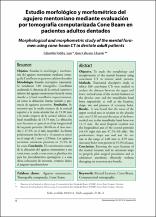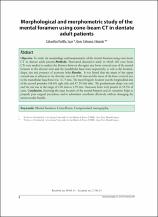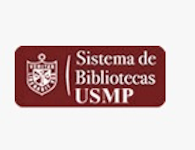Mostrar el registro sencillo del ítem
Estudio morfológico y morfométrico del agujero mentoniano mediante evaluación por tomografía computarizada Cone Beam en pacientes adultos dentados
| dc.contributor.author | Cabanillas Padilla, Juan | |
| dc.contributor.author | Quea Cahuana, Eduardo | |
| dc.date.accessioned | 2020-06-15T14:22:01Z | |
| dc.date.available | 2020-06-15T14:22:01Z | |
| dc.date.issued | 2014-11 | |
| dc.identifier.citation | Cabanillas J., Quea E. Estudio morfológico y morfométrico del agujero mentoniano mediante evaluación por tomografía computarizada Cone Beam en pacientes adultos dentados. Odontoestomatología. 2014; 16(24): 4-12. | es_PE |
| dc.identifier.uri | https://hdl.handle.net/20.500.12727/6208 | |
| dc.description | Abstract Objective. To study the morphology and morphometry of the mental foramen using cone-beam CT in dentate adult patients. Methods. Transversal descriptive study in which 180 cone-beam CTs were studied to analyze the distance between the upper and lower cortical areas of the mental foramen to the alveolar crest and the mandibular basal bone respectively, as well as the location, shape, size and presence of accessory holes. Results. It was found that the mean of the upper cortical area in relation to the alveolar crest was 15.00 mm and the mean of the lower cortical area to the mandibular basal bone was 13.75 mm. The most frequent location was the longitudinal axis of the second premolar (44.4% right side and 47.2% left side). The predominant shape was oval and the size was in the range of 2.00 mm to 2.99 mm. Accessory holes were present in 55.5% of cases. Conclusion. Knowing the exact location of the mental foramen and its variations helps to properly plan surgical procedures and to administer anesthesia effectively without damaging the neurovascular bundle. | es_PE |
| dc.description.abstract | Objetivo. Estudiar la morfología y morfometría del agujero mentoniano mediante tomografía ConeBeam en pacientes adultos dentados Metodología. Estudio descriptivo transversal. Se estudiaron 180 tomografías ConeBeam analizando la distancia de la cortical superior e inferior del agujero mentoniano hasta la cresta alveolar y la basal mandibular respectivamente, así como la ubicación, forma, tamaño y presencia de agujeros accesorios. Resultados. Se encontró que la media respecto de la cortical superior a la cresta alveolar fue de 15.00 mm y la media respecto de la cortical inferior a la basal mandibular de 13.75 mm. La ubicación más frecuente se apreció en el eje longitudinal del segundo premolar (44.4% en el lado derecho y 47.2% en el lado izquierdo). La forma predominante fue la oval y el tamaño se ubicó en el rango de 2 mm a 2.99mm. Los agujeros accesorios estuvieron presentes en 55.5% de los casos. Conclusión. El conocimiento exacto de la ubicación del agujero mentoniano y sus variaciones, ayuda a una correcta planificación para los procedimientos quirúrgicos, y a una eficaz colocación de anestesia, evitando daños al paquete vasculonervioso | es_PE |
| dc.format.extent | pp. 4-12 | es_PE |
| dc.language.iso | spa | es_PE |
| dc.publisher | Facultad de Odontología - Universidad de la República | es_PE |
| dc.relation.ispartof | urn:issn:1575-1813 | |
| dc.relation.ispartofseries | Odontoestomatología;vol. 16, no. 24 | |
| dc.relation.uri | http://www.scielo.edu.uy/scielo.php?script=sci_arttext&pid=S1688-93392014000200002 | es_PE |
| dc.rights | info:eu-repo/semantics/openAccess | es_PE |
| dc.rights.uri | https://creativecommons.org/licenses/by-nc/4.0/ | es_PE |
| dc.source | Repositorio Académico USMP | es_PE |
| dc.source | Universidad San Martín de Porres - USMP | es_PE |
| dc.subject | Foramen mental | es_PE |
| dc.subject | Tomografía computarizada por rayos x | es_PE |
| dc.subject | Mandíbula | es_PE |
| dc.title | Estudio morfológico y morfométrico del agujero mentoniano mediante evaluación por tomografía computarizada Cone Beam en pacientes adultos dentados | es_PE |
| dc.title.alternative | Morphological and morphometric study of the mental foramen using cone-beam CT in dentate adult patients | es_PE |
| dc.type | info:eu-repo/semantics/article | es_PE |
| thesis.degree.name | Medicina Humana | es_PE |
| thesis.degree.grantor | Universidad de San Martín de Porres. Facultad de Medicina Humana | es_PE |
| thesis.degree.discipline | Medicina | es_PE |
| dc.publisher.country | UY | es_PE |
| dc.subject.ocde | https://purl.org/pe-repo/ocde/ford#3.02.00 | es_PE |
Ficheros en el ítem
Este ítem aparece en la(s) siguiente(s) colección(es)
-
Artículos [274]









